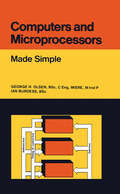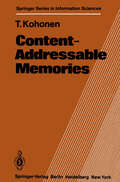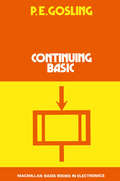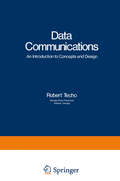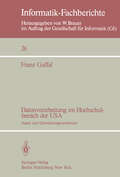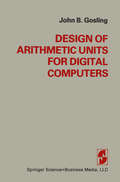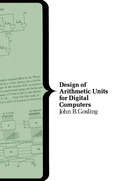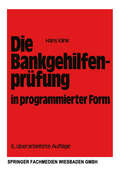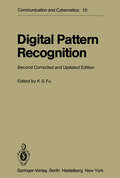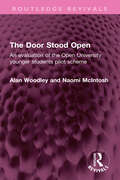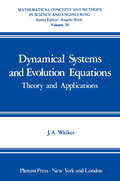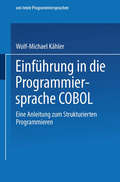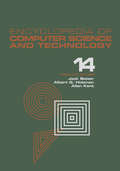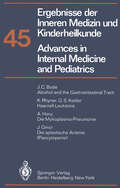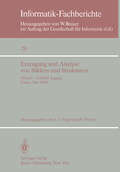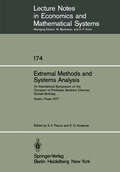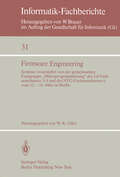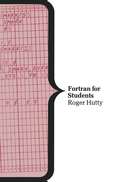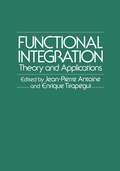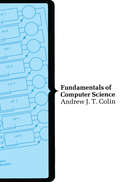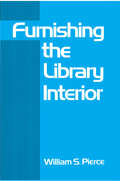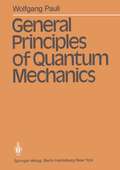- Table View
- List View
Computers and Microprocessors: Made Simple
by George H. Olsen Ian BurdessComputers and Microprocessors: Made Simple covers the basic concepts and applications of computers and microprocessors. The book discusses the basic concepts behind the architecture of a small digital computer including logic systems and the major functional blocks of the computer. The text also tackles the applications and operation of analog computers, electronic analog computers, and digital computers and its software (higher-level programming languages and flowcharts). Microprocessors are also discussed with regard to its evolution, architecture, types, and future trends. Students taking computer courses will find the book useful.
Content-Addressable Memories (Springer Series in Information Sciences #1)
by T. KohonenDesigners and users of computer systems have long been aware of the fact that inclusion of some kind of content-addressable or "associative" functions in the storage and retrieval mechanisms would allow a more effective and straightforward organization of data than with the usual addressed memories, with the result that the computing power would be significantly increased. However, although the basic principles of content-addressing have been known for over twenty years, the hardware content-addressable memories (CAMs) have found their way only to special roles such as small buffer memories and con trol units. This situation now seems to be changing: Because of the develop ment of new technologies such as very-large-scale integration of semiconduc tor circuits, charge-coupled devices, magnetic-bubble memories, and certain devices based on quantum-mechanical effects, an increasing amount of active searching functions can be transferred to memory units. The prices of the more complex memory components which earlier were too high to allow the application of these principles to mass memories will be reduced to a fraction of the to tal system costs, and this will certainly have a significant impact on the new computer architectures. In order to advance the new memory principles and technologies, more in formation ought to be made accessible to a common user.
Data Communications: An Introduction to Concepts and Design (Applications of Modern Technology in Business)
by Robert TechoThis book has evolved primarily from lecture notes for data communications courses taught at Georgia State University since 1969. Additional material was derived from seminar presentations that were made during this period as well as from consulting work. Teaching data communications in the College of Business Administration influenced the point of view of this material, giving it a semitechnical orientation. This point of view has been extended to the prepara tion of this book. Only those technical details were included which, it was felt, would lead the student to a better understanding of the subject. References are provided for those who desire further information in particular areas. The reader for whom this book is intended is the nontechnical person who has some knowledge of computer technology and who wishes to extend that knowledge to the field of data communications. The two key points stressed in this book are terminology and concepts. The objectives of this book are to enable the student: 1. To read articles in the field of data communications with an understand ing of their content. 2. To be able to engage in knowledgeable discussions with communica tions engineers on the subject of data communications. 3. To design and implement the hardware aspects of applications using data communications. The software that would be involved is beyond the scope of this book except where protocols are considered. v vi Preface 4. To effectively evaluate proposals for the implementation of data com munications systems.
Datenverarbeitung im Hochschulbereich der USA: Stand und Entwicklungstendenzen (Informatik-Fachberichte #26)
by Franz GaffalDesign of Arithmetic Units for Digital Computers
by GOSLINGThe original motivation for the development of digital computers was to make it possible to perform calculations that were too large to be attempted by a human being without serious likelihood of error. Once the users found that they could achieve their initial aims, they then wanted to go into greater detail, and to solve still bigger problems, so that the demand for extra computing power has continued unabated, and shows no sign of slackening. This book is an attempt to describe some of the more important techniques used today, or likely to be used in the near future, to perform arithmetic within the computing machine. There are, at present, few books in this field. Most books on computer design cover the more elementary methods, and some go into detail on one or two more ambitious units. Space does not allow more. In this text the aim has been to fill this gap in the literature. In selecting the topics to be covered, there have been two main aims: first, to deal with the basic procedures of arithmetic, and then to carry on to the design of more powerful units; second, to maintain a strictly practical approach. The number of mathematical formulae has been kept to a minimum, and the more complex ones have been eliminated, since they merely serve to obscure the essential principles.
Digital Pattern Recognition (Communication and Cybernetics #10)
by T. M. Cover Edwin Diday K. S. Fu A. Rosenfeld J. C. Simon T. J. Wagner J. S. Weszka J. J. WolfSince its publication in 1976, the original volume has been warmly received. We have decided to put out this updated paperback edition so that the book can be more accessible to students. This paperback edition is essentially the same as the original hardcover volume except for the addition of a new chapter (Chapter 7) which reviews the recent advances in pattern recognition and image processing. Because of the limitations of length, we can only report the highlights and point the readers to the literature. A few typographical errors in the original edition were corrected. We are grateful to the National Science Foundation and the Office of Naval Research for supporting the editing of this book as well as the work described in Chapter 4 and a part of Chapter 7. West Lafayette, Indiana March 1980 K. S. Fu Preface to the First Edition During the past fifteen years there has been a considerable growth of interest in problems of pattern recognition. Contributions to the blossom of this area have come from many disciplines, including statistics, psychology, linguistics, computer science, biology, taxonomy, switching theory, communication theory, control theory, and operations research. Many different approaches have been proposed and a number of books have been published. Most books published so far deal with the decision-theoretic (or statistical) approach or the syntactic (or linguistic) is still far from its maturity, many approach.
The Door Stood Open: An evaluation of the Open University younger students pilot scheme (Routledge Revivals)
by Alan Woodley Naomi McIntoshFirst published in 1980 The Door Stood Open deals with an early demand upon open university policy. It deals with important themes like context of the younger students pilot scheme; demand for open university places among the younger age group; motivational factors and potential study problems; the impact of open university study on the younger students; students who withdrew from the open university; younger students who could not attend full-time courses and how the younger students fared. In an age when distance learning is becoming a norm, this book serves as an important historical document for educationists and policy makers.
The Door Stood Open: An evaluation of the Open University younger students pilot scheme (Routledge Revivals)
by Alan Woodley Naomi McIntoshFirst published in 1980 The Door Stood Open deals with an early demand upon open university policy. It deals with important themes like context of the younger students pilot scheme; demand for open university places among the younger age group; motivational factors and potential study problems; the impact of open university study on the younger students; students who withdrew from the open university; younger students who could not attend full-time courses and how the younger students fared. In an age when distance learning is becoming a norm, this book serves as an important historical document for educationists and policy makers.
Dynamical Systems and Evolution Equations: Theory and Applications (Mathematical Concepts and Methods in Science and Engineering #20)
by John A. WalkerThis book grew out of a nine-month course first given during 1976-77 in the Division of Engineering Mechanics, University of Texas (Austin), and repeated during 1977-78 in the Department of Engineering Sciences and Applied Mathematics, Northwestern University. Most of the students were in their second year of graduate study, and all were familiar with Fourier series, Lebesgue integration, Hilbert space, and ordinary differential equa tions in finite-dimensional space. This book is primarily an exposition of certain methods of topological dynamics that have been found to be very useful in the analysis of physical systems but appear to be well known only to specialists. The purpose of the book is twofold: to present the material in such a way that the applications-oriented reader will be encouraged to apply these methods in the study of those physical systems of personal interest, and to make the coverage sufficient to render the current research literature intelligible, preparing the more mathematically inclined reader for research in this particular area of applied mathematics. We present only that portion of the theory which seems most useful in applications to physical systems. Adopting the view that the world is deterministic, we consider our basic problem to be predicting the future for a given physical system. This prediction is to be based on a known equation of evolution, describing the forward-time behavior of the system, but it is to be made without explicitly solving the equation.
Einführung in die Programmiersprache COBOL: Eine Anleitung zum Strukturierten Programmieren (uni-texte Programmiersprachen)
by Wolf-Michael KählerEncyclopedia of Computer Science and Technology: Volume 14 - Very Large Data Base Systems to Zero-Memory and Markov Information Source
by Jack Belzer Albert G. Holzman Allen Kent"This comprehensive reference work provides immediate, fingertip access to state-of-the-art technology in nearly 700 self-contained articles written by over 900 international authorities. Each article in the Encyclopedia features current developments and trends in computers, software, vendors, and applications...extensive bibliographies of leading figures in the field, such as Samuel Alexander, John von Neumann, and Norbert Wiener...and in-depth analysis of future directions."
Encyclopedia of Computer Science and Technology: Volume 14 - Very Large Data Base Systems to Zero-Memory and Markov Information Source
by Jack Belzer Albert G. Holzman Allen Kent"This comprehensive reference work provides immediate, fingertip access to state-of-the-art technology in nearly 700 self-contained articles written by over 900 international authorities. Each article in the Encyclopedia features current developments and trends in computers, software, vendors, and applications...extensive bibliographies of leading figures in the field, such as Samuel Alexander, John von Neumann, and Norbert Wiener...and in-depth analysis of future directions."
Ergebnisse der Inneren Medizin und Kinderheilkunde / Advances in Internal Medicine and Pediatrics (Ergebnisse der Inneren Medizin und Kinderheilkunde. Neue Folge Advances in Internal Medicine and Pediatrics #45)
by P. Frick G.-A. von Harnack G. A. Martini A. PraderErzeugung und Analyse von Bildern und Strukturen: DGaO — DAGM Tagung Essen, 27. – 31. Mai 1980 (Informatik-Fachberichte #29)
by S. J. Pöppl H. PlatzerExtremal Methods and Systems Analysis: An International Symposium on the Occasion of Professor Abraham Charnes’ Sixtieth Birthday Austin, Texas, September 13 – 15, 1977 (Lecture Notes in Economics and Mathematical Systems #174)
by A. V. Fiacco K. O. KortanekThe papers appearing in this Volume were selected from a collec tion of papers presented at the Internationa~ Symposium on Extrema~ Methods and Systems Ana~ysis on the Occasion of Professor A. Charnes' 60th Birthday, at the University of Texas in Austin, 13-15 September 1977. As coeditors, we have followed the normal editorial procedures of scholarly journals. We have obtained invaluable assistance from a number of colleagues who essentially performed the duties of associate editors, coordinating most of the reviews. All papers except those appearing in the Historica~ Perspectives section were refereed by at least two individuals with competency in the respective area. Because of the wide range and diversity of the topics, it would have been im possible for us to make a consistently rational selection of papers without the help of the associate editors and referees. We are indeed grateful to them. The breadth of extremal methods and systems analysis, suggested by the range of topics covered in these papers, is characteristic of the field and also of the scholarly work of Professor Charnes. Extre mal methods and systems analysis has been a pioneering and systematic approach to the development and application of new scientific theories and methods for problems of management and operations in both the pri vate and public sectors, spanning all major disciplines from economics to engineering.
Firmware Engineering: Seminar veranstaltet von der gemeinsamen Fachgrupe „Mikroprogrammierung“ des GI Fachausschusses 3/4 und des NTG-Fachausschusses 6 vom 12. – 14. März 1980 in Berlin (Informatik-Fachberichte #31)
by W. K. GiloiFunctional Integration: Theory and Applications
by Jean-Pierre Antoine Enrique TirapeguiThe idea of the workshop on Functional Integration, Theory and Applications, held in Louvain-Ia-Neuve from November 6 to 9 1979, was to put in close and informal contact, during a few days, active workers in the field. There is no doubt now that functional integration is a tool that is being applied in all branches of modern physics. Since the earlier works of Dirac and Feynman enormous progress has been made, but unfortunately we lack still a unifying and rigo rous mathematical framework to account for all the situations in which one is interested. We are then in presence of a rapid ly changing field in which new achievements, proposals, and points of view are the normal pattern. Considering this state of affairs we have decided to order the articles starting from the more fundamental and ambitious from the point of view of mathematical rigour, followed by ar ticles in which the main interest is the application to con crete physical situations. It is obvious that this ordering should not be taken too seriously since in many cases there will be an interplay of both objects.
Furnishing the Library Interior
by William S PierceThis book discusses the selection, evaluation, and purchase of furniture and equipment for libraries. It examines the arrangement of the interior to update and illuminate earlier writings, and helps those spending even small amounts for library furniture and equipment to do so more wisely.
Furnishing the Library Interior
by William S PierceThis book discusses the selection, evaluation, and purchase of furniture and equipment for libraries. It examines the arrangement of the interior to update and illuminate earlier writings, and helps those spending even small amounts for library furniture and equipment to do so more wisely.
General Principles of Quantum Mechanics
by Wolfgang PauliI am very happy to accept the translators' invitation to write a few lines of introduction to this book. Of course, there is little need to explain the author. Pauli's first famous work, his article on the theory of relativity in the Encyklopädie der Mathematischen Wissenschaften was written at the age of twenty. He afterwards took part in the development of atomic physics from the still essentially classical picture of Bohr's early work to the true quantum mechanics. Thereafter, some of his work concerned the treatment of problems in the framework of the new theory, especially his paper on the hydrogen atom following the matrix method without recourse to Schrodinger's analytic form of the theory. His greatest achievement, the exclusion principle, generally known today under his own name as the Pauli principle, that governs the quantum theory of all problems including more than one electron, preceded the basic work of Heisenberg and Schrodinger, and brought him the Nobel prize. It includes the mathematical treatment of the spin by means of the now so well known Pauli matrices. In 1929, in a paper with Heisenberg, he laid the foundation of quantum electrodynamics and, in doing so, to the whole theory of quantized wave fields which was to become the via regia of access to elementary particle physics, since here for the first time processes of generation and annihilation of particles could be described for the case of the photons.
